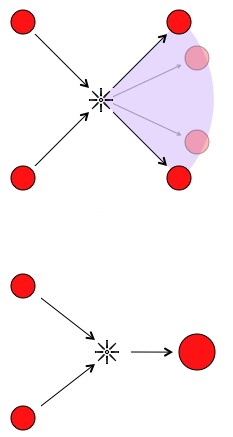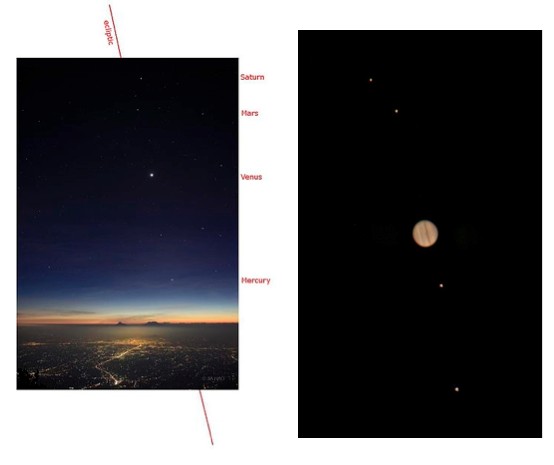Physicist: This may be the shortest answer yet: “accretion“.
Accretion is the process of matter gravitationally collapsing from a cloud of dust or gas or (usually) both. Before thinking about what a big cloud of gas does when it runs into itself, it’s worth thinking about what happens to just two clumps of dust when they run into each other.

Most collisions are inelastic, which means they lose energy and that the particles’ trajectories are “averaged” a little. In the most extreme case things will stick together.
In a perfectly elastic collision objects will bounce out at about the same angle that they came in. Most collisions are inelastic, which means they lose energy and the angle between the objects’ trajectories decreases after a collision. In the most extreme inelastic case the particles will stick together. For tiny particles this is more common than you might think.

Table salt, in zero gravity, spontaneously clumping due to electrostatic forces (click image for movie).
Over time collisions release energy (as heat and light). This loss of energy causes the cloud to physically contract, since losing energy means the bits of dust and gas are moving slower (and that means falling into lower and lower orbits). But collisions also make things “average” their trajectories. So while a big puffy cloud may have bits of dust and gas traveling every-which-way, during accretion they eventually settle into the same, average, rotational plane.
Each atom of gas and mote of dust moves along its own orbital loop, pulled by the collaborative gravitational influence of every other atom and mote (there’s no one point where the gravity originates). While the path of each of these is pretty random, there’s always net rotation in some direction. The idea is any cloud in space starts out with at least a little bit of spin. This isn’t a big claim; pour coffee into a cup, and at least some little bits will be turning. That same turbulence shows up naturally at all larger-than-coffee-cup scales in the universe (although typically not much smaller). So, on average, any cloud will be turning in some direction.
Things in the cloud will continue to run into each other until every part of it has done one of three things: 1) escaped, 2) fallen into the center, or 3) moves with the flow. Most of the cloud ends up in the center. For example, our Sun makes up 99.86% of the matter in the solar system. The stuff that stops colliding and goes with the flow forms the ring. Anything not in the plane of the ring must be on an orbit that passes through it, which means that it will continue hitting things and losing energy. Eventually, the “incorrectly orbiting” object will either find itself co-orbiting with everything else in the ring, or will loose enough kinetic energy to fall into the planet or star below. By the way, there’s still a lot of “unaffiliated” junk in our solar system that’s still waiting to “join” a planet.
Those rings are pretty exciting places themselves. Inside of them there are bound to be “lumps” of higher density that draw in surrounding material. Eventually this turns into smaller accretion disks within the larger disk. Our solar system formed as a disk with all of the planets forming within that disk in the “plane of the ecliptic”. One of those lumps became Jupiter, which has its own set of moons that also formed in an accretion disk around Jupiter. In fact, Jupiter’s moons are laid out so much like the rest of the solar system (all orbiting in the same plane) that they helped early astronomers to first understand the entire solar system. It’s hard to see how the planets are moving from a vantage on the surface of one of those moving planets (Earth), so it’s nice to have a simple boxed example like Jupiter.

The planets always lie within the same plane, “the ecliptic”. Since the Earth is also in this plane, the ecliptic appears as a band in the sky where the Sun and all of the planets can be found. Similarly, Jupiter’s moons also lie in a plane.
That all said, those lumps add an element of chaos to the story. Planets and moons don’t simply orbit the Sun, they also interact with each other. Sometimes this leads to awesome stuff like planets impacting each other and big explosions. One of the leading theories behind the formation of our Moon is one such impact. But these interactions can sometime slingshot smaller objects into weird, off-plane orbits. Knowing that planets tend to be found in the same plane make astronomer’s jobs that much easier. From Earth, the ecliptic appears as a thin band that none of the other planets stray from. Pluto was the second dwarf planet found (after Ceres) because it orbits close to the plane of all the other planets, and is inside this band. The dwarf planet Xena and its moon Gabriel orbit way off of the ecliptic, which is a big part of why they weren’t found until 2005 (the sky is a big place after all). Xena and Gabriel’s official names are “Eris” and “Dysnomia” respectively, but I support the original discoverer’s labels, because they’re amazing. So things can have wonky orbits, but they need to do it way the crap out there where they don’t inevitably run into something else. Xena is usually about twice as far out as Pluto, which itself is definitively way the crap out there.
Not all matter forms accretion disks. In order for a disk to form the matter involved has to interact. Gas and dust does a great job of that. But once they’ve formed, stars barely interact at all. For example, when (not if!) the Andromeda and Milky Way galaxies hit each other, it’s really unlikely that any stars will smack into each other (they’re just too small and far apart). However, the giant gas clouds in each should slam into each other and spark a flurry of new star formation. In four billion years the sky will be especially pretty.








So why do certain planets have rings? Saturn, with 60 moons (satellites), appears to be generating a new one from its outer ring. Why don’t all planets have rings? Or moons? Make this make sense!
All four gas giants do have rings, it’s just that Saturn’s are the most pronounced. The size of the ring as well as the number of moons is kind of a crap shoot. The formation process is full of a lot of random interactions. Looking at all of the thousands of planets we’ve found (the vast majority are around other stars) we find that they come in all sizes in all orbits.
To follow up on David B. Smith’s question, why don’t the terrestrial planets have rings? Is it because they’re too small, too hot, or made of rock?
Two quick questions. First, why a 2D disk and not a 1D ring? Along the same lines, in N spatial dimensions, would accretion result in an N-1 dimensional disk or something else?
Thanks
Eric
@Eric
a 1D ring (closed line) can only exist within the confines of 2D+, so all ‘rings’ are at least two-dimensional. but leaving that aside…
if you’re starting off with disorganized, random arrangements in space, you’re dealing with a volume of particles. so for 3D space you have a 3D volume of particles. from there it is sufficient to consider that the total angular momentum has to be conserved, and like any spinning structure, it will bulge away from the axis of spin. because the dust / particles are only loosely held together (by gravity, which is rather weak) there is little resistance to the entire ‘structure’ flattening out into a plane perpendicular to the axis of spin, giving discs and (when viewed from far away enough) rings.
higher numbers of spatial dimensions doesn’t really work well with gravity; my understanding is it would not be stable and according to quick searches even the solar system wouldn’t be stable in 4D. in theory you could still form rings – what type of rings i don’t know for sure. either you will end up with the same 2D accretion disc in 4D space, or possibly a toroid, or a higher-dimensional equivalent.
if you like though, you could solve for the two-body problem using 4 (or more) spatial dimensions to get an understanding of a stable orbit first (if one exists), and extend the result to the size and speeds of the disc. ie, the disc forms out of a ‘perfect’ orbit because the particles will interact, lose energy, fall inwards, and self-average into a ring again (ie, a torus/doughnut shape due to ‘pulling’ or stretching a circle inwards). who knows, it might be stable in 4+ dimensions, but from what i’ve read so far i don’t expect it to be.
From a Mathematician 😉
If i understand your mean of flatness faithfully:
Solar system (Sun+objects that orbits it) is not flat(=a property describing levelness), means that planet are not orbiting Sun as Rings of Saturn do.(planets are not leveled; they aren’t orbiting Sun all in one plane but different planes(angled relative to each other).what called orbital inclination is about this , however as Physicist you can neglect that slight angles.(but the argument shall base upon ; why Solar system could be considered flat NOT why Solar System is flat).
by the way, the statement ;”The planets always lie within almost the same plane, “the ecliptic”.” should be corrected to <>
Solar system is not a flat disk , it could be considered one.
Please correct me if i’m not.
Thanks
Pingback: Dwarf planet Xena renamed Eris | Dear Kitty. Some blog
Eric ignoring the fact that the inverse laws of other dimensions tend to produce instability in any odd number of dimensions accretion will result in a disk with n-1 dimensions and in an even number of dimensions accretion will result in a sphere with n dimensions. The reason for this is because in an even number of dimensions there can be n/2 independent directions of rotation while in an odd number of dimensions there can be (n-1)/2 independent directions of rotation.
Pingback: چرخش زمین | مجموعه علمی، خرس آبی
2 questions from a layman.
Why does a spiral galaxy have spirals and not look like a solar system ?
Is it because of recent (billions of years ago) collisions of other galaxies ?
Also . . . If our sun is made of hydrogen and helium . . .
Why does it burn and not just explode ?
Please respond.
As per your explanation, a portion of gas released in some corner of the empty room should not spread homogeneously over the room but rather form a rotating disk/ring? Doesn’t it contradict an experimental evidence?
you guys dont have info related to the question
Pingback: Why Galaxies Come in Different Shapes | HowStuffWorks
Pingback: Q: Could dark matter actually be the “gravitational shadow” of parallel universes? | Ask a Mathematician / Ask a Physicist
Pingback: Q: How likely is it that there’s dark matter in me right now? | Ask a Mathematician / Ask a Physicist
Pingback: Pentru priam data a fosst descoperita o planeta in alta galaxie – REVISTA VEGA
Pingback: Types of Galaxies: Why Galaxies Come in Different Shapes - Softs Geek